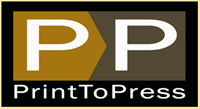 PrintToPress home of print on demand and self publishing
Print on demand $1.94 a 45 p book, B&W text with Full color lam cover, fast tunaround
PrintToPress home of print on demand and self publishing
Print on demand $1.94 a 45 p book, B&W text with Full color lam cover, fast tunaround
Print On Demand
Posted on 15. Mar, 2011 by vostrovsky in Print On demand
Print on demand (POD) is a term for the technology that allows a complete book to be printed and bound in minutes. The printing used for the most part is digital printing which makes it cost effective and allows the publisher to order as few as one or two books at a time (there is no limit at the upper end).
A good Print On Demand price for an order of a single book, should not be more than the price of a book in a standard printing of a medium run. (medium being a minimum of 1000 copies).
Traditional publishers use (POD) to fill orders on books that have lower order numbers, just to keep them on their lists. Print On Demand is most often used to sell books via online book stores, eliminating the need for large stocks.
Commercial and academic publishers use Print On Demand to print advance reading copies for books before their actual publications and use provide them to the various media outlets for reviews.
Just like traditional publishers, authors can use Print On Demand in the same way.
- Provide their books to a reading audience through online book stores without maintaining a stock.
- Send copies for review by media, both local and national.
- Send copies to publishers and book agents, many authors were picked up by traditional publishers after they published themselves.
The term vanity publishing was coined by publishers who wanted to maintain control over their “stable” of authors and preserve their grip on the industry.
Self publishing is no longer frowned on as it fulfills a niche that readership demand compared to mass market publishing which requires a broad appeal. An author who was not excepted in his/her first few tries by the publishers but could build a following using POD and social networking, can earn a place in the “stable” (if he wants, with a commercial publisher if that is what he/she wants.
Print-on-demand publishing services utilize digital and online technology to provide publishing services to writers. They range from TheBookPatch.com and PrintToPress.com, which provides free online templates that allow anyone to upload and format a book, (TheBookPatch.com also provide writing tools) to websites that promise publishing packages that include editing, custom cover design, enhanced marketing, and other extremely expensive extras known as milking the author.
Aside from a few POD services that are free (ThBookPatch.com and PrintToPress.com) most will set you back anywhere from a few hundred to several thousand dollars. They don’t typically screen submissions; if they do, it’s usually only to exclude pornography or hate literature. If you want to go beyond the basics (formatting, printing, binding, ISBN numbers, and listings with online vendors), and add editing, proofreading, custom design, marketing services, and the like, you will either have to purchase these extras separately–either from the POD service or an independent provider–or trade up to a more expensive package. (for more on this topic read “Do you judge a book by its cover?”)
Most POD services contracts should take only nonexclusive digital rights, and can be terminated at will. You need to remember though that POD services more often than not determine prices based on printing costs, and pay the author a specified percentage of the sale price. Some will demand to have copyright to the book and the author can then buy his books at a discount.
POD services call what they offer self-publishing–but there are important differences between a POD service and traditional self-publishing.
TheBookPatch.com and PrintToPress.com are true POD Self Publishing providers.
- Control. With true self-publishing, the writer controls all aspects of the publishing process, from cover art to print style to pricing. Unlike TheBookPatch.com and PrintToPress.com most POD services, choice is typically limited to the package of services the publisher offers.
- Revenue. With true self-publishing such as TheBookPatch.com and PrintToPress.com, the writer keeps all proceeds from sales. With most other POD services, the service keeps the lion’s share of sales proceeds to offset printing costs, and pays the author a percentage–either a percentage of income (a royalty) or a percentage of profit. Basically, you’re paying twice: once upfront, and once with each book produced and sold.
- Rights. With true self-publishing such as TheBookPatch.com and PrintToPress.com all rights remain with the writer, who has full ownership of his/her books, including the ISBN number. With most POD services, the POD service owns the ISBN, and has a limited claim on digital and/or electronic publishing rights.
